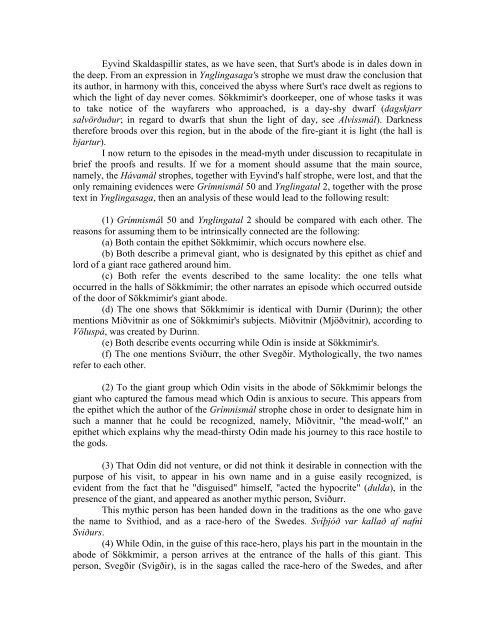Chapters 44-95 - Germanic Mythology
Chapters 44-95 - Germanic Mythology
Chapters 44-95 - Germanic Mythology
Create successful ePaper yourself
Turn your PDF publications into a flip-book with our unique Google optimized e-Paper software.
Eyvind Skaldaspillir states, as we have seen, that Surt's abode is in dales down in<br />
the deep. From an expression in Ynglingasaga's strophe we must draw the conclusion that<br />
its author, in harmony with this, conceived the abyss where Surt's race dwelt as regions to<br />
which the light of day never comes. Sökkmimir's doorkeeper, one of whose tasks it was<br />
to take notice of the wayfarers who approached, is a day-shy dwarf (dagskjarr<br />
salvörðuður; in regard to dwarfs that shun the light of day, see Alvíssmál). Darkness<br />
therefore broods over this region, but in the abode of the fire-giant it is light (the hall is<br />
bjartur).<br />
I now return to the episodes in the mead-myth under discussion to recapitulate in<br />
brief the proofs and results. If we for a moment should assume that the main source,<br />
namely, the Hávamál strophes, together with Eyvind's half strophe, were lost, and that the<br />
only remaining evidences were Grímnismál 50 and Ynglingatal 2, together with the prose<br />
text in Ynglingasaga, then an analysis of these would lead to the following result:<br />
(1) Grímnismál 50 and Ynglingatal 2 should be compared with each other. The<br />
reasons for assuming them to be intrinsically connected are the following:<br />
(a) Both contain the epithet Sökkmimir, which occurs nowhere else.<br />
(b) Both describe a primeval giant, who is designated by this epithet as chief and<br />
lord of a giant race gathered around him.<br />
(c) Both refer the events described to the same locality: the one tells what<br />
occurred in the halls of Sökkmimir; the other narrates an episode which occurred outside<br />
of the door of Sökkmimir's giant abode.<br />
(d) The one shows that Sökkmimir is identical with Durnir (Durinn); the other<br />
mentions Miðvitnir as one of Sökkmimir's subjects. Miðvitnir (Mjöðvitnir), according to<br />
Völuspá, was created by Durinn.<br />
(e) Both describe events occurring while Odin is inside at Sökkmimir's.<br />
(f) The one mentions Sviðurr, the other Svegðir. Mythologically, the two names<br />
refer to each other.<br />
(2) To the giant group which Odin visits in the abode of Sökkmimir belongs the<br />
giant who captured the famous mead which Odin is anxious to secure. This appears from<br />
the epithet which the author of the Grímnismál strophe chose in order to designate him in<br />
such a manner that he could be recognized, namely, Miðvitnir, "the mead-wolf," an<br />
epithet which explains why the mead-thirsty Odin made his journey to this race hostile to<br />
the gods.<br />
(3) That Odin did not venture, or did not think it desirable in connection with the<br />
purpose of his visit, to appear in his own name and in a guise easily recognized, is<br />
evident from the fact that he "disguised" himself, "acted the hypocrite" (dulda), in the<br />
presence of the giant, and appeared as another mythic person, Sviðurr.<br />
This mythic person has been handed down in the traditions as the one who gave<br />
the name to Svithiod, and as a race-hero of the Swedes. Svíþjóð var kallað af nafni<br />
Sviðurs.<br />
(4) While Odin, in the guise of this race-hero, plays his part in the mountain in the<br />
abode of Sökkmimir, a person arrives at the entrance of the halls of this giant. This<br />
person, Svegðir (Svigðir), is in the sagas called the race-hero of the Swedes, and after
















